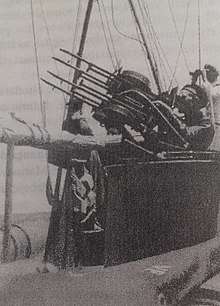NMS Viscolul
 Viscolul arriving in the port of Constanța, 1940 | |
| History | |
|---|---|
| Name: | MTB-23 |
| Builder: | Vospers, Portsmouth |
| Laid down: | 1939 |
| Launched: | 1939 |
| Completed: | 1939 |
| Commissioned: | 1939 |
| Out of service: | 1940 |
| Fate: | Sold to Romania |
| Name: | Viscolul |
| Commissioned: | 1940 |
| Out of service: | 1944 |
| Fate: | Captured by the Soviet Union |
| Name: | TK-955 |
| Commissioned: | 1944 |
| Out of service: | 1945 |
| Fate: | Returned to Romania, later scrapped |
| Service record | |
| Commanders: | Ion Zaharia |
| Operations: | |
| Victories: |
|
| General characteristics | |
| Class and type: | Vospers type motor torpedo boat |
| Type: | Motor torpedo boat/Escort vessel |
| Displacement: | 32 tons |
| Length: | 21.95 m (72 ft 0 in) |
| Beam: | 5 m (16 ft 5 in) |
| Draft: | 1.1 m (3 ft 7 in) |
| Propulsion: | 3 Isotta-Fraschini petrol engines, 2 shafts, 3,450 horse power |
| Speed: | 40 knots (74 km/h; 46 mph) |
| Complement: | 12 |
| Armament: |
|
NMS Viscolul was the most successful and the longest-serving motor torpedo boat of the Romanian Navy during the Second World War. She supported the Siege of Odessa and took part in the Action of 9 July 1941.
Construction and specifications
Viscolul was a Vospers-type motor torpedo boat, one of three purchased by Romania from the United Kingdom. The three boats were originally launched and completed in 1939 as MTB-20 (Viforul), MTB-21 (Vijelia) and MTB-23 (Viscolul). They were acquired by Romania in 1940. Along with her sister ships, Viscolul had a displacement of 32 tons, measuring 21.95 meters in length, with a beam of 5 meters and a draught of 1.1 meters. She was armed with two quadruple 7.7 mm machine guns, two torpedo tubes and could carry up to 8 depth charges or 4 mines. Power plant consisted of three Isotta Fraschini petrol engines powering 2 shafts, generating 3,450 hp which gave her a top speed of 40 knots. She had a crew of up to 12.[1][2]
Service

During World War II, she was commanded by Lieutenant-Commander Ion Zaharia, who would later command the motor torpedo boat Vedenia and the entire Romanian MTB squadron, consisting of 7 boats.[3]
On 9 July 1941, one week after Romania launched Operation München as part of Operation Barbarossa, Viscolul and Vijelia, together with the 250t-class torpedo boat Năluca, engaged an enemy submarine near Mangalia. Năluca was the first to arrive at the scene and subsequently located and engaged the Soviet Shchuka-class submarine Shch-206. In the first part of the battle, Năluca attacked the submarine with 20 mm rounds, but the latter submerged in order to escape. The Romanian torpedo boat subsequently used depth charges, being soon joined by the two motor torpedo boats. At 2:56 pm, the Soviet submarine was confirmed sunk by Viscolul, none of her crew of 38 survived.[4][5][6][7]
On the night of 18 September, during the Siege of Odessa, Viscolul and Vijelia attacked a Soviet convoy south of Odessa, each boat launching her two torpedoes at the closest enemy destroyer. Three of the four torpedoes missed. The fourth torpedo struck and damaged the Soviet destroyer, but failed to detonate.[8][9]
On 9 November 1941, her sisters Viforul and Vijelia were sunk near Odessa by Soviet mines.[10]
Thus, Viscolul remained the sole MTB of the Romanian Navy for almost two years, until 7 MAS boats were acquired in August 1943.[11] By 1944, Viscolul was fitted for escort service. In this capacity, she carried out multiple escort missions in May 1944.[12]
Viscolul herself was captured by Soviet forces in September 1944 and commissioned as TK-955. She was returned 1 year later, but never commissioned again due to her bad condition.[13]
References
- ↑ Robert Gardiner, Conway's All the World's Fighting Ships 1922-1946, Naval Institute Press, 1980, p. 362
- ↑ Navypedia: VIFORUL motor torpedo boats (1939/1940)
- ↑ Jipa Rotaru, Ioan Damaschin, Glorie și dramă: Marina Regală Română, 1940-1945, Ion Cristoiu Publishing, 2000, p. 258
- ↑ Antony Preston, Warship 2001-2002, Conway Maritime Press, 2001, p. 72
- ↑ Cristian Crăciunoiu, Romanian navy torpedo boats, Modelism, 2003, p. 135
- ↑ Donald A Bertke, Gordon Smith, Don Kindell, World War II Sea War, Volume 4: Germany Sends Russia to the Allies, Bertke Publications, 2012, p. 134
- ↑ Jipa Rotaru, Ioan Damaschin, Glorie și dramă: Marina Regală Română, 1940-1945, Ion Cristoiu Publishing, 2000, pp. 34, 50 and 51
- ↑ Jipa Rotaru, Ioan Damaschin, Glorie și dramă: Marina Regală Română, 1940-1945, Ion Cristoiu Publishing, 2000, pp. 74-75
- ↑ Jipa Rotaru, Octavian Burcin, Vladimir Zodian, Mareșalul Ion Antonescu: Am făcut "războiul sfânt" împotriva bolșevismului: Campania anului 1941, p. 180
- ↑ Donald A Bertke, Gordon Smith, Don Kindell, World War II Sea War, Volume 4: Germany Sends Russia to the Allies, Bertke Publications, 2012, p. 390
- ↑ Robert Gardiner, Conway's All the World's Fighting Ships 1922-1946, Naval Institute Press, 1980, p. 314
- ↑ Antony Preston, Warship 2001-2002, Conway Maritime Press, 2001, p. 84
- ↑ Navypedia: VIFORUL motor torpedo boats (1939/1940)